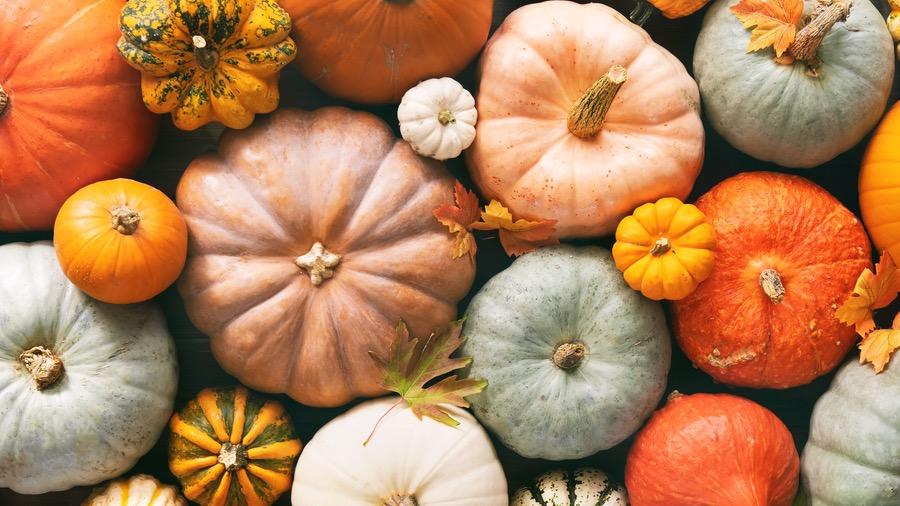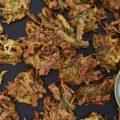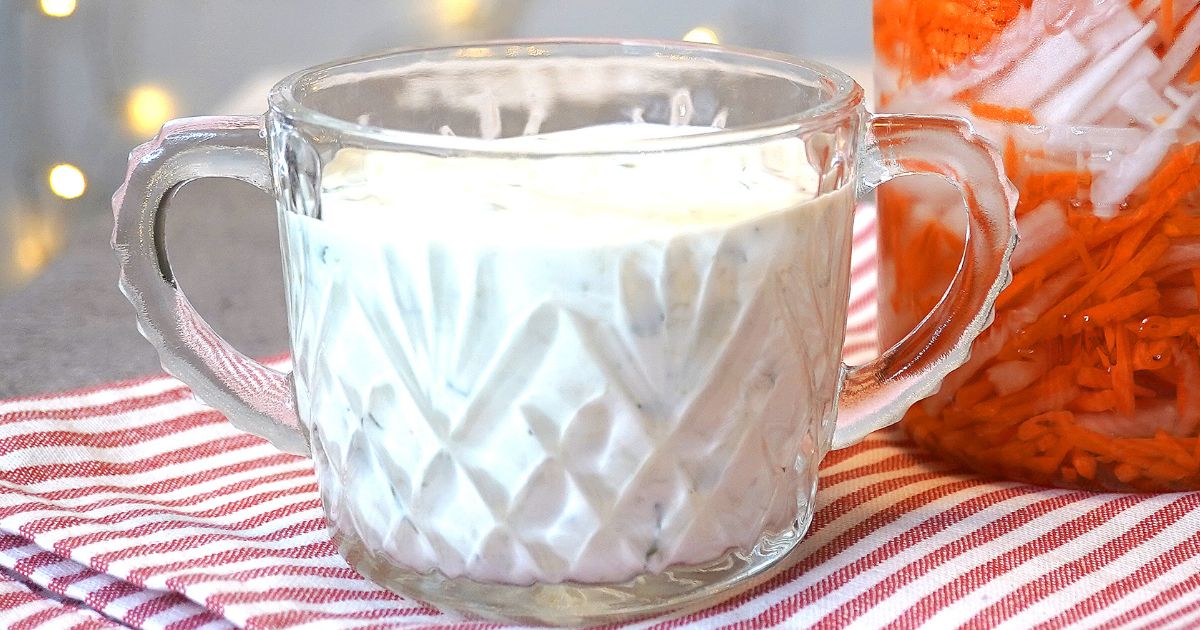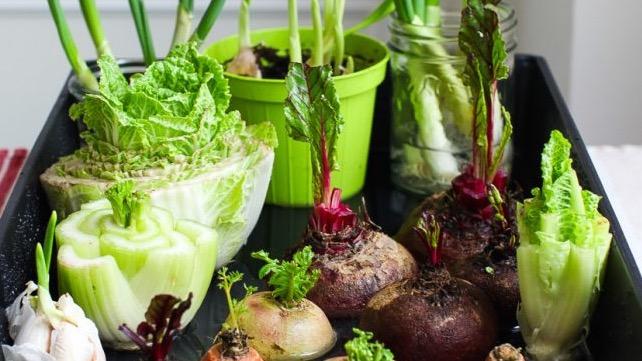Pumpkin spice this, pumpkin spice that. From lattes to air fresheners, clearly there’s just some voodoo magic in the combination of cinnamon, nutmeg, ginger, and cloves. Sure, it tastes great, and it does smell lovely, but it must run deeper than that. I’m guessing the aroma transports us to cozy family times at Thanksgiving and Christmas – which, I do realize is rather ethnocentric of me – I mean, what do folks from parts of the world where pumpkin pie isn’t a thing, think of this flavour fad?
And when I say it runs deeper, there seems to be some sort of primal reaction to the stuff; as evidenced by a study I read, demonstrating the scents of cinnamon and vanilla were just as effective a stimulant for men, as that little blue pill. Huh! Whose grandma didn’t dab some vanilla behind her ears back in the day?
- Pumpkins come in an earthy rainbow of colours, from dark green to soft pink
- About the size of a baseball, these little pumpkins make lovely tea light holders for the fall table

Even the biggest foodies among us only consider the pleasures of pumpkins in the fall, and that’s often restricted to eating pie and carving Jack O’Lanterns, but there are hundreds of varieties eaten on a daily basis around the world, in stews, curries, rice dishes, fritters, and so much more. Pumpkin – in one form or another – is a favourite ingredient in Caribbean, Korean, Japanese, South East Asian, African, and many Continental cuisines.

For the class I taught, I made a curried pumpkin soup (recipe to follow), pan-roasted some seeds in foolish amounts of butter, whipped up a batch of pumpkin pancakes, and deep fried some golden pumpkin fritters (keep reading for this recipe too).

Pumpkins are gorgeous to look at. They can be flat and gunmetal blue; white and round; grey and warty; long and lemon yellow, and on and on and on. Inside all of them, the seeds are good eats, and the flesh is similar in flavour to our classic orange pumpkin or squash, with soft to dense in textures. If you want to experiment with new and unusual pumpkin varieties, visit ethnic grocery stores, where year ‘round, you’ll find many varieties to choose from. Some of the bigger specimens will already be cut up into manageable portions. Once you’ve found a new and different squash or pumpkin to try, treat it as you would any of the more familiar varieties: peel, grate, chop, roast, fry, or stew until tender. Tip: pumpkin and coconut milk are besties!
If you have some space – okay, lots of space – in the garden, why not try growing something different next summer? When those seed catalogues land in your mailbox this February, linger a little longer over the squash, gourd, and pumpkin pages, see what’s on offer, then take a chance on something new. One of my favourite gardening gurus, Niki Jabbour, digs into this very topic in her book, Veggie Garden Remix. Grab a copy and get inspired.
What we in North American call a pumpkin may be known as squash in other parts of the world, and what we might identify as squash is called pumpkin elsewhere. By any name, this North American native is good eats – leaves, flowers, seeds, flesh, oil and all!
Thai Curry Pumpkin Soup with Coriander-Scallion Yogurt
Here’s a soup you can make at any time of the year. It’s pretty, filling, and healthy, and it’s spicy without being hot. Red Thai curry paste can be found in most grocery stores, but the intensity of spice differs from brand to brand, so taste as you go. For this recipe, I use Blue Dragon brand. It’s less concentrated than some, so use three tablespoons. Also, if you have a fish allergy, note that most brands contain shrimp and/or anchovy. In that case, look for a vegan brand or use a yellow East Indian curry instead.
Ingredients
- 3 Tbsp. (45 mL) olive oil or coconut fat
- 1 medium red onion, peeled and coarsely chopped
- 2 Tbsp. (30 mL) peeled and finely chopped fresh ginger root (about 5 cm knob)
- 2 garlic cloves, minced
- 1 to 3 Tbsp. (15 to 45 mL) Thai red curry paste
- ¼ cup (60 mL) dry white wine
- 1 796 mL can pure pumpkin meat (or roast your own pie pumpkin to make about 3 1/3 cups)
- 1 796 mL can chopped tomatoes, with the juice
- 1 900 mL tetra pack organic chicken or mushroom broth
- 1 398 mL can coconut milk
- 1 tsp (5 mL) toasted sesame oil
- ½ tsp (2 mL) pepper
Method
- Into a large, heavy-bottomed saucepan over medium-low heat, add onion and ginger; stir often, cooking until just softened and translucent but not browned, about 5 minutes. Add garlic; stir often and cook for another 3 minutes, but do not brown. Add curry paste and wine; stir until well combined, with no lumps of curry paste remaining.
- Add pumpkin meat, tomatoes and juice, broth, coconut milk, sesame oil and pepper. Stir until well blended. Increase heat to medium and bring to a simmer. Simmer uncovered for about 15 minutes, stirring often to prevent sticking. Reduce heat if soup begins to boil. Puree soup with an immersion blender, or transfer soup in batches into a blender, leaving the vent open to prevent steam build up. When smooth, taste and adjust for seasoning, though, between the curry paste, broth and canned tomatoes, the finished soup should be pretty tasty!
- Transfer soup to a serving dish and serve with a selection of garnishes: finely chopped Thai chili, sliced scallions, fresh coriander leaves and coriander-scallion yogurt (recipe follows).
Makes about 12 cups (3 L)
Coriander-Scallion Yogurt
The creaminess of the yogurt cools and enrichens the soup, while the coriander and lime add a dash of freshness. (Note: Soak the coriander in ice cold water for a few minutes to remove the grit before rinsing and drying with either a kitchen towel or salad spinner.)
Ingredients
1 Tbsp. (15 mL) freshly squeezed lemon or lime juice
½ bunch (about 2 cups (500 mL, loosely packed) fresh coriander (leaves and tender stems only), washed and dried
6 scallions, washed, trimmed white and green parts, coarsely chopped
1 tsp (5 mL) sea salt
1 cup (250 mL) plain full-fat yogurt
Method
Place ingredients into a blender or food processor and puree. Transfer to a dish or cream jug for pretty pouring at the table.

Perfect Pumpkin-Onion-Apple Fritters
This works with squash just as well; so make them year ‘round! These fritters are everything a fritter should be: lacy, crunchy, bursting with sweet – that’s the apple – and savoury goodness. Made with chickpea flour, they’re also gluten-free.
Ingredients
1 large purple onion, shredded or super-thinly sliced
About 2 cups (500 mL) shredded pumpkin or squash
1 apple, grated
1 small hot chili, finely minced
1 cup (250 mL) fresh mint, coarsely chopped
1 cup (250 mL) fresh coriander leaves and tender stems, coarsely chopped
1 tsp (5 mL) turmeric
1 tsp (5 mL) whole coriander seeds
1 tsp (5 mL) garam masala
1 tsp (5 mL) fine sea salt
Approximately or up to 2 cups (500 mL) chick pea flour (gram flour)
Up to ½ cup (125 mL) water, more or less
Oil for deep frying; enough to fill a high-sided pot two-thirds the way up
Method
- The key to making blow-your-mind fritters is in the water-flour-ingredient ratio, but, most importantly, it’s in the way you arrive there.
- First, you will need a really big bowl; you need room to stir. Second, for best results, use your hand to stir. So wash up and remove the bling. And, thirdly, and perhaps most importantly, add the flour and water to the ingredients a bit at a time. We are not making a batter and then adding veggies; it’s the other way around. We are making a veggie mix and adding flour and water to it to hold it together, and wait until you see – and taste – the difference for yourself.
- Into a very large bowl, add all the ingredients except the flour, water, and oil for frying. Stir and toss the apples and veggies together with the spices until nicely combined.
- Now, start adding the flour, a few shakes at a time, stirring with one hand, adding flour with the other. Stop and rest for a few minutes, and notice how the apples and veggies release some moisture; add some more flour to soak that up. You might need to add a drop of water at this point.
- What you are looking for is a thick pancake-like batter coating that doesn’t completely smother all the veggies. When you grab up a small handful of veggies in batter, you should be able to squeeze it and have it hold together. If not, keep adding flour and water; shake by shake, drop by drop. Stir, stir, stir.
- Once you have a nice gooey batter holding it all together—you may or may not have used all the flour and water; that’s ok!—set the bowl aside while you bring the oil up to between 325F to 350F (160C to 180C) in a large, high-sided pot or wok. Best to use a deep fat thermometer for this. Too cold and the fritters will be leaden and greasy; too hot and they’ll burn outside and be raw and doughy inside.
- Set up a cooling rack over a sheet pan near the stove to drain the finished fritters.
- To test the heat of the oil, drop in one little bit of battered mixture, and if it starts to sizzle immediately and bobs up to the surface within a second or two, you’re good to go. But keep an eye on the oil temperature, and don’t over-crowd the oil; just drop in a few pinches—about 2 Tbsp (30 mL) each—at a time. Use a slotted spoon or Chinese spider to move them around and flip them over. When they are golden brown—about 2 minutes on each side—lift and transfer to cooling rack.
- Serve with store-bought tamarind sauce or make a batch of Maple-Mint Apple Raita.
Makes about 25 to 30 bite-size fritters
Maple-Mint Apple Raita
This dip is cooling, refreshing, and delicious and can be enjoyed alongside curries, as a dip for chips and raw veggies, or even as a salad dressing. Indian black salt is salt with the sulphur still attached; so it has an amazing hard-boiled egg smell and flavour. It’s an acquired taste to be sure; look for it in East Indian grocers, or skip it, if you’re not a fan of that sulfurous aroma.
Ingredients
- 1 large apple, grated
- 1 cup (250 mL) Greek or other thick, plain yogurt
- 2 Tbsp (30 mL) raw apple cider vinegar
- 1 Tbsp (15 mL) maple syrup
- ¼ cup (60 mL) finely chopped fresh mint
- 2 Tbsp (30 mL) finely chopped coriander leaves
- 1 tsp (5 mL) fine sea salt
- ¼ tsp (1 mL) white pepper or more to taste
- Garnish with a generous pinch of Indian black salt, optional
Method
- Wash and grate the apple into a bowl. Toss with a pinch of salt and a splash of cider vinegar and transfer to a sieve over a bowl to drain, while you prepare the rest. The longer it drains, the better and the less watery the raita will be in the end.
- In a medium bowl, add the yogurt, vinegar, mint, coriander, salt and pepper; stir to combine.
- Squeeze the apple a few times to get the last of the juice out, then add it to the yogurt mixture; stir well to combine.
- Garnish with a pinch of sulphurous black salt, if desired. Serve immediately or cover and refrigerate for up to 3 days.
Makes about 2 cups (500 mL)

Pumpkin for your Pets
Did you know, many dogs and cats – and chickens too! – love the taste of pumpkin, which is great, since it’s super healthy for them. A spoonful or two of cooked pumpkin meat is a natural cure for diarrhea and constipation; it’s also loaded with beta carotene – hence its neon orange colour – which Fido and Fluffy convert to vitamin A. And when Jack is done shining his spooky light on Halloween, give him to your backyard flock; chickens love pecking away at an unwanted pumpkin.
From Hudson, Quebec, now living in Port Hope, Ontario, Signe is a restaurant chef-turned-writer who tells award-winning stories and creates delicious recipes for LCBO’s Food & Drink, Manna Pro Hearty Homestead, The Harvest Commission, and Today’s Parent; she published her first book – Happy Hens & Fresh Eggs; Keeping Chickens in the Kitchen Garden with 100 Recipes – in 2015.













